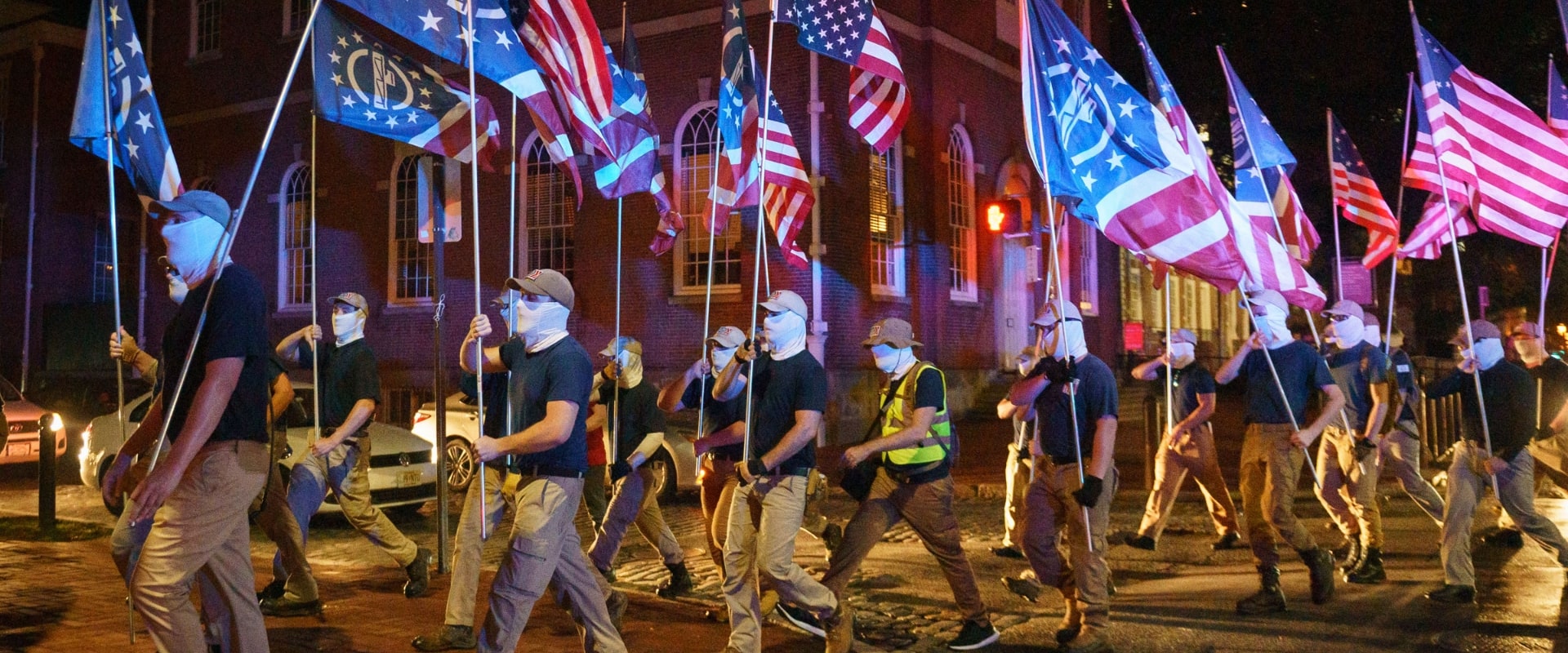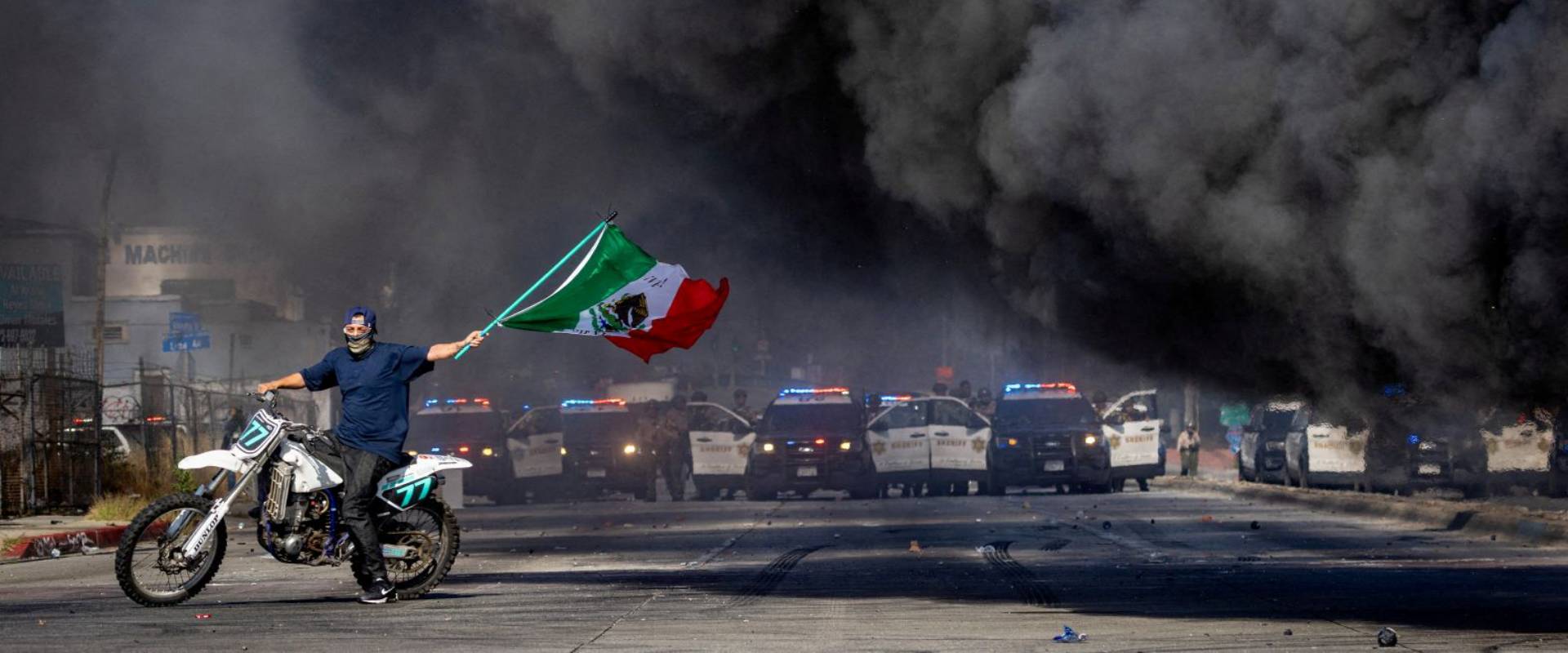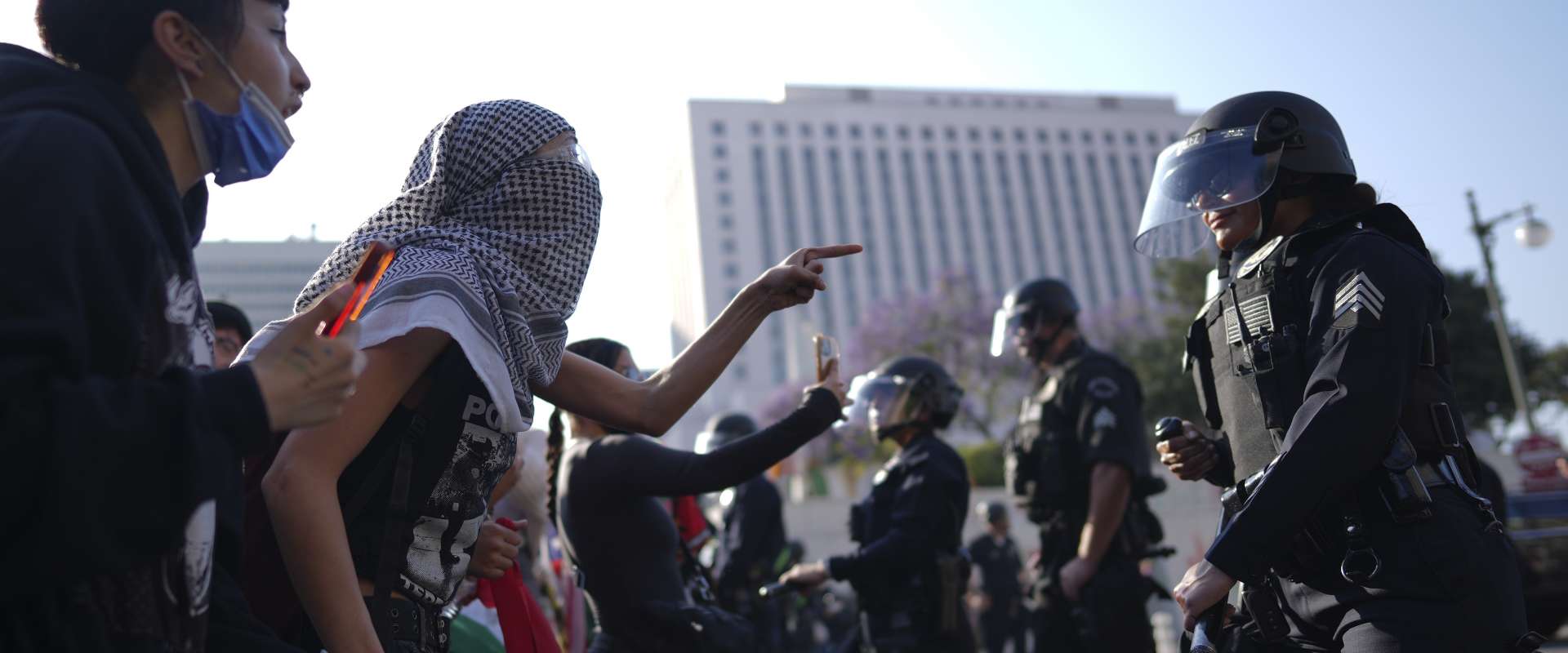Fascism arose in the 20th century as a capitalist response to its own crises and the increased threat of the communist movement after the Russian Revolution. Fascism is a symptom of capitalism in decay, and is especially centered on the ruined petty bourgeoisie and declassed workers.
Leon Trotsky provided some of the most incisive analysis of fascism as a phenomenon. In “Democracy and Fascism,” he wrote,
At the moment that the ‘normal’ police and military resources of the bourgeois dictatorship, together with their parliamentary screens, no longer suffice to hold society in a state of equilibrium — the turn of the fascist regime arrives. Through the fascist agency, capitalism sets in motion the masses of the crazed petty bourgeoisie and the bands of declassed and demoralized lumpenproletariat — all the countless human beings whom finance capital itself has brought to desperation and frenzy.
In this extreme situation, the bourgeoisie uses the fascist movement as a weapon against the workers’ movement. The triumph of fascism requires the defeat of the working class and the destruction of its mass organizations. The bourgeoisie only turns to fascism when all other methods of suppressing the workers’ movement — for example through co-optation or state repression — have failed. Fascism is, as Trotsky wrote in Fascism: What It Is and How to Fight It, the “party of counter-revolutionary despair.”
In Whither France?, Trotsky wrote,
It may be said that fascism is the act of placing the petty bourgeoisie at the disposal of its most bitter enemies. In this way, big capital ruins the middle classes and then, with the help of hired fascist demagogues, incites the despairing petty bourgeoisie against the worker.
Donald Trump is neither fascist nor proto-fascist. Trump winning a second term as president will not bring fascism to the US. Still, confusion and panic over Trump prevail on the broad left. Many progressives and liberals have campaigned for Joe Biden, not on the basis of his merits, but to forestall Trump’s “fascist threat” to the country. That Biden’s supporters cling to him as their salvation against Trump while ignoring or downplaying his complicity in genocide is just one sign of the incoherence of their arguments.
However, in clarifying these things, we should not dismiss the real dangers of Trump — his vile racism and sexism, his persecution of immigrants and Muslims, his wrecking-ball approach to public institutions and policy. While Trump’s second election would not bring in fascism, it would signify a shift toward a more authoritarian form of bourgeois democracy, somewhat like Viktor Orbán in Hungary or Narendra Modi in India; and it would certainly galvanize his far-right supporters.
We need to better articulate these questions in our propaganda. We need to explain and differentiate two ongoing and important developments in the US. The first is the political polarization in the working class and middle classes, and the relative growth of proto-fascist and white-supremacist groups, which have often posed a real threat to the left and the oppressed at the street level.
The second is the nature of the Trump movement, the role it is playing in the ongoing class struggle, and its relation with the bourgeois-democratic regime.
Regarding fascism, we need to first start by saying that, according to the Marxist conception:
- Fascism refers to a particular kind of regime, not only a government or a cabinet. That is to say, it refers to a drastic restriction of the institutions of bourgeois parliamentarism in favor of institutions such as the military and fascist militias
- Fascism emerges in the context of extreme economic and social crisis, combined with class struggle that has deepened to such an extent that the survival of the capitalist system may be threatened
- Fascism is defined by the participation and organization of wide sectors of the middle classes into militant strata that attack the organized left, the labor movement, and sectors of the working class in struggle; and which are based upon chauvinistic ideologies (white supremacy, antisemitism, etc.)
The far right in the US today
Capitalist restructuring and austerity in the neoliberal era set the table for the current situation. As the lives of working people become more precarious and the petty bourgeoisie slip further down the economic ladder, the right offers them an easy answer — it’s the immigrants, Muslims, Black and Latinx people, LGBTQ+ people, or the Jews who are at fault. White nationalism appeals to this unease by exploiting the demographic changes in the US that will make white people a minority in less than 20 years. This milieu also thrives on conspiracy theories to bolster their narratives.
In the wake of the 2008 election of Barack Obama as president, sections of capital including Koch Industries and some oil magnates began funneling money into the right-wing “grassroots” organizations that became the Tea Party movement. Tied in with an underlying racial backlash against the first Black president, proponents of this anti-tax, anti-regulation, and pro-austerity movement went on to capture positions inside the GOP.
Anti-government militia groups and other hate groups grew during the Obama years. The so-called alt-right emerged as a reboot of the far right with more mainstream messaging and appearance. A broad spectrum of forces emerged that defended social inequality and increasingly rejected the existing political order, including various stripes of white supremacists, white nationalists, the Christian right, and patriot militias.
The triumph of fascism requires the defeat of the working class and the destruction of its mass organizations. The bourgeoisie only turns to fascism when all other methods of suppressing the workers’ movement — for example through co-optation or state repression — have failed. Fascism is, as Trotsky wrote, the “party of counter-revolutionary despair.”
Groups like the Proud Boys, the Oath Keepers, the Three Percenters, the National Socialist Movement, Identity Evropa/American Identity Movement, Patriot Prayer, and other white-nationalist, fascist, and militia groupings have achieved a certain level of operational unity in this era. This unity in action was forged from a turning point at the deadly 2017 Charlottesville rally, hardened in street fighting in Portland and Kenosha during the 2020 George Floyd Uprising, and saw its most virulent expression in the January 6, 2021 riot in Washington, DC.
The red-baiting, racist, and xenophobic rhetoric of Trump and his supporters have given these groups the confidence to act under the broad aegis of Trumpism. But again, we do not believe Trump and his political allies are fascists. No wing of the ruling class is ready to deploy fascist goon squads to break up union meetings and smash up union halls. The ruling-class faces no immediate, powerful class threat to its plans. Today, they give encouragement but not massive funding to far-right militias; and the aims of these militia groups are far more limited than they would be under fascism.
At the same time, keeping small groups on the far right in play is one tool in the ruling class’s effort to combat the Black Lives Matter, anti-fascist, LGBTQ+, and immigrant-rights movements. These far-right groups are all too willing to comply, as they, correctly or not, see a threat to the status quo and their own livelihoods in these social movements. The deployment of right-wing militias can be expected to increase as the mass of unemployed workers who face ruin go into motion to demand an end to evictions, mass unemployment, and income loss.
Most of the historic lessons about how to fight fascism apply in a general sense to our current tasks. While we understand that fascism is not the order of the day, we must do everything in our power to limit the violence meted out to our class and to mitigate the attraction of these groups to the lower middle classes and declassed workers.
Fascist forces are finding fertile ground and a willing mass audience for their ideas among far-right conspiracists like the QAnon movement and the anti-vax/anti-lockdown movement. COVID denialism, toxic ideas about sinister “globalists,” and paranoia about Chinese plots to take over the US are rampant on the far right, and have seeped into the broader right wing.
Antisemitic, xenophobic, and anti-communist conspiracy theories like these may contribute to building a mass base for a fascist movement as crisis and resistance deepen. Already the QAnon movement has attracted hundreds of thousands of sympathizers and has inspired individual acts of terror. Far from dismissing them as cranks, we take this movement seriously as a dangerous step towards fascist growth in the future.
This struggle to defang and limit the damage from these forces is international, as proto-fascist and right-populist forces surge worldwide from Russia to the Philippines to Brazil.
Cops and fascism
In Portland, Minneapolis, Kenosha, Denver, and countless other places, we have seen collusion between police and the far right. The police are part of the raw material of fascism. In Countermobilization: A Strategy to Fight Racist and Fascist Attacks, Farrell Dobbs noted this about the ruling class and the police:
Their tactic is to protect the rights of the fascists while at the same time using fascist forces to try to keep others from exercising those rights. One of the forces used to implement this is the most malevolent of all the repressive instruments of capitalist rule, the police forces. The police structure is of a character that makes it a breeding ground for fascists.
You don’t only have an army of capitalist cops that represses opponents of capitalism, you have a ripe recruiting ground for fascism itself. You not only have cops implementing ruling-class orders in aiding the fascists, you have a police force that is honeycombed with fascists.
How not to fight fascism and the far right
First, we cannot rely on the cops, courts, and liberal politicians to protect us. Voting for one capitalist party to stop the other — the strategy of lesser-evilism — won’t work and has never worked.
Reformist and class-collaborationist strategies like the popular front are a recipe for defeat. Revolutionary-socialist analysis of the 1930s shows that attempts to use a popular front to respond to fascism led to disaster after disaster. Similarly, the failure of the Communist Party of Germany (KPD) to organize united fronts with social democrats signaled to Trotsky that there was no reforming the Stalinized Third International, and that revolutionaries must break with it once and for all.
We do not believe Trump and his political allies are fascists. No wing of the ruling class is ready to deploy fascist goon squads to break up union meetings and smash up union halls. The ruling-class faces no immediate, powerful class threat to its plans.
History tells us that we must also avoid adventurist and substitutionist tactics that isolate us from the masses. In general, we must caution activists against bringing guns to demonstrations. Such actions by unorganized individuals can expose the movement to repression, especially given the frequent lack of centralized leadership. On the one hand, it can give police and right-wingers a pretext to use deadly force. Needless deaths and defeats will only demoralize our class, demobilize the movement, and teach the false lesson that if we fight back, we will lose.
Even a very temporary and conjunctural “victory,” such as the retreat of a right-wing group from the streets due to the “military” action of a few freelancing militants, teaches the equally false lesson that fascism and the right can be defeated by combatants operating independently from the political organizations of the class. The result of substitutionism is most often repression against the most defenseless part of the class.
How to fight fascism and the far right
Central to the struggle against fascism are proletarian methods of struggle:
- Mass counter-mobilization in a united front is one of the central methods our movement has used successfully. By this, we mean the mobilization of the broadest possible social forces against the fascists. Crucial to this is the participation of the mass organizations of the working class and the oppressed. While unions may be slow to move, we should continue to call on them to act, and stress that if they don’t stand against fascists, they are the next victims.
- We must develop the organized self-defense of our organizations, marches, meetings, and ultimately our class. One first step is developing regular and accountable protest marshals, who seek to protect our marches from individual and organized far-right disruption and help to drive these forces out. Organized defense guards can protect meetings from provocateurs. However, steps on this front must not be taken lightly or in isolation from the organizations of the working class and its allies.
- How we discuss the question of force is important. The capitalist state won’t hesitate to victimize anti-fascists or ignore the violence of the right wing. We use defensive formulations — advocating for the right to self-defense of workers and the oppressed. We must know the balance of forces and the capabilities of the enemy.
Most of the historic lessons about how to fight fascism apply in a general sense to our current tasks. While we understand that fascism is not the order of the day, we must do everything in our power to limit the violence meted out to our class and to mitigate the attraction of these groups to the lower middle classes and declassed workers.
- Far-right individuals and fascist organizations also use doxxing and other digital tactics to intimidate and target members of oppressed groups, socialists, and working-class activists. Digital security is an important element of strategy, but must be organized in concert with mass-defense campaigns. Furthermore, concerns for such security must not override the need to protest in public.
- When faced with right-wing or fascist speakers at a university or commercial venue, rather than ask authorities to ban them, we counter-mobilize against them in the largest numbers possible to make them unwelcome and to demonstrate their lack of support. In this way, we demonstrate bottom-up power to fight the right without giving authorities the precedent to limit left-wing speakers.
- Fighting fascism requires independent organizing by the working class and oppressed people, including a clean break with the Democrats and the construction of an independent workers’ party with a militant class-struggle program. In today’s political climate it is essential to counteract those in the movement who urge us to vote for the Democrats to defeat the “fascist” Republican. Arguing that a career neoliberal, imperialist politician or their party will protect us from fascists is a fantasy. The genocide happening in Gaza is a horrifying demonstration that lesser-evilism is a sham.
- Consideration also has to be given to how to win sections of the petty bourgeoisie to a working-class political program. Propaganda and demands must be aimed at these social layers who might otherwise constitute the social base of fascism. This requires a decisive and resolute working-class leadership and no watering-down of the party program to win these layers. In “Fascism and Big Business,” Dan Guerin writes: “In short, the proletariat cannot win over the middle classes by renouncing its own socialist program. The proletariat must convince the middle classes of its capacity to lead society onto a new road; by the strength and firmness of its revolutionary action. But it is precisely this that the inventors of the ‘Popular Fronts’ do not wish to understand.”
- The fight against fascism is primarily a political struggle bound to the question of revolutionary socialist party-building, and mass activity of movements of the oppressed and exploited. Political shortcuts are not an option. Every aspect of anti-fascist action must be considered carefully. The slogans we raise to bring workers, the oppressed, and the youth into motion have to be formulated to push the struggle forward. Only the construction of a revolutionary socialist party that looks capable of solving the crisis by taking power, and is seen as such by not only the working class, but discontented middle-class layers as well, can ultimately defeat fascism.
Conclusion: Why does it matter if we call Trump a fascist?
An important part of organizing to fight fascism is the Marxist view of what fascism really is. Why does it matter whether we call Trump or the US in general fascist? We all agree Trump is a vicious bigot with extreme authoritarian tendencies. Isn’t this dispute just a tempest in a teapot about terminology and definitions that have no impact on activity? There are two main reasons this argument is important.
First, it directly influences strategies. If we are in immediate danger of living in a totalitarian society like Nazi Germany or fascist Italy, the left needs to go underground as soon as possible. In those societies, once actual fascism was consolidated, open opposition was virtually impossible. There were no unions to organize class struggle openly. There was no free press. There was no protection for the right to demonstrate in any way. All leftist organizing in those societies had to be underground.
Acceptance of Trump as genuinely fascist implicitly calls for those methods to be adopted now. But premature attempts to go underground would divert energy from what is possible now — open propaganda and open organizing of the class struggle and social movements. Large sections of the population are now open to Marxism, and increasingly so, especially in the wake of Gaza. For revolutionaries to head underground is to abstain from the most effective strategies now. It is to separate Marxists from the growing struggles today.
Misunderstanding the distinction between fascism and bourgeois democracy disorients the left toward ultra-leftism, accommodation to liberal capitalism, or complacency about the real fascist threat — and sometimes all three at once.
Those who believe that fascism is imminent may also be tempted to adopt terrorist tactics, which would further isolate revolutionaries from the masses of people struggling for progress. Others who adopt the fascist designation flip the other way and in desperation run to the courts and the Democrats to defend them. Either of these strategies are disastrous for the left.
Another possible response is complacency in relation to the actual fascist threat. If fascism is imminent, why pay attention to opposing the small fascist groups that could lay the basis for actual fascism in the future? Why build united fronts to oppose the far right?
Misunderstanding the distinction between fascism and bourgeois democracy disorients the left toward ultra-leftism, accommodation to liberal capitalism, or complacency about the real fascist threat — and sometimes all three at once. The second reason to be clear and concise about the definition of fascism is that labeling Trump fascist is a formulation that leaves bourgeois democracy off the hook.
Fascism is not primarily a moral designation. It is a precise, scientific analysis of capitalism in crisis which implies a strategic perspective. Bourgeois democracy has been capable of outrageous inhumanity throughout history, and still is today. The US was founded on genocide and slavery. Millions of Africans were killed in the slave trade. This too was surely a holocaust.
The genocide of Native people and the complete destruction of hundreds or thousands of unique cultures and languages has to rank high on the list of the inhumanity of the human species. These happened before fascism was even thought of.
The history of the US is a history of vicious class struggle by the rulers against workers and the poor. The suppression of the rights of women, LGBTQ+ people, immigrants, and racial minorities was replete throughout US history and continues today. Today, bourgeois democracy is leading the way to a climate catastrophe that could destroy civilization if not the whole human race.
Those who designate Trump as fascist or near-fascist use it as a blanket damnation. They define all that is evil as fascist. But in doing so, they are saying that normal bourgeois democracy is not evil, or not as evil. Would the survivors of Hiroshima, Nagasaki, Dresden, Vietnam, or Iraq agree with that?
Accepting bourgeois democracy as morally superior to fascism leaves the door open to accommodation to the liberal wing of the bourgeoisie. It leads to popular frontism, which actually leads to the success of fascism. In today’s elections, it leads to those on the left surrendering their principles and supporting the moderate wing of the bourgeois dictatorship. It puts a barrier in the way of independent working-class organizing.
Some misguided leftists make the opposite mistake: they argue that precisely because of the slavery, oppression, and genocide that has characterized its history, the US has always been fascist. This fallacy muddles the concrete analysis of what fascism really is under capitalism in crisis. Despite coming from a different place than the liberal tendency to label Trump as a unique threat, it leads to similar strategic blunders.
For revolutionaries, the fundamental difference between fascism and bourgeois democracy is not moral but strategic. The need for different strategies and tactics flow from how we describe and analyze a particular society.
None of this is to imply that Marxists don’t prefer bourgeois democracy to fascism. Of course we do. The reason we prefer it is because bourgeois democracy makes it more possible to openly organize against the capitalist system. But we don’t accept bourgeois democracy as a positive good. We oppose fascism because it is an obstacle to overthrowing capitalism which includes bourgeois democracy. We fight alongside supporters of bourgeois democracy against fascism, but always with the goal of turning that fight into a fight against capitalism in general.
This is a modified version of an article originally written by the Revolutionary Socialist Network, a predecessor organization of Firebrand that existed from 2019 to 2022.
Image: Patriot Front in Philadelphia, July 2021. Photo by Jessica Griffin for The Philadelphia Inquirer.



